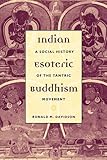Indian esoteric Buddhism : a social history of the Tantric movement / Ronald M. Davidson.
Material type: TextPublisher number: EB00639074 | Recorded BooksPublication details: New York : Columbia University Press, ©2002.Description: 1 online resource (xvi, 475 pages) : illustrationsContent type:
TextPublisher number: EB00639074 | Recorded BooksPublication details: New York : Columbia University Press, ©2002.Description: 1 online resource (xvi, 475 pages) : illustrationsContent type: - 0231501021
- 9780231501026
- 294.3/925/0954 21
- BQ8912.9.I5 D38 2002eb
- online - EBSCO
| Item type | Current library | Call number | URL | Status | Notes | Barcode | |
|---|---|---|---|---|---|---|---|
 eBook
eBook
|
Biblioteca "Angelicum" Pont. Univ. S.Tommaso d'Aquino Nuvola online | online - EBSCO (Browse shelf(Opens below)) | Online access | Not for loan (Accesso limitato) | Accesso per gli utenti autorizzati / Access for authorized users | (ebsco)75343 |
Includes bibliographical references (pages 419-464) and index.
Print version record.
Maps and Illustrations; Preface; Acknowledgments; Pronunciation and Orthographic Guide; 1. Introduction: A Plethora of Premises; Habits of the Heart, Deductive Premises, and Buddhist Inhibitions; Petrarch's Method: Artes Historicae in the Renaissance; Tropes, Heuristics, and Other Dangerous Things; 2. Prayers in the Palace, Swords in the Temple: Early Medieval India; The Occlusion of the Medieval; Early Medieval Political and Military Events; The Culture of Military Opportunism; Aesthetics and the Apothosis of Kingship; Feudalization of Divinity; Conclusion: Early Medieval Vitality.
3. The Medieval Buddhist ExperienceGuilds, Commerce, and Political Legitimacy; Politics, Patronage, and Ethics -- the Loss of Kuntala and Andhrapatha; Medieval Women's Buddhism -- Hidden from View or Missing in Action?; A Loss of Footing: The Agenda of Skepticism; Looking Elsewhere for Direction: The Turn to Epistemology; Big Important Monasteries -- Administrators in Maroon Robes; Conclusion: A Tradition Under Duress; 4. The Victory of Esoterism and the Imperial Metaphor; Chronology: The Seventh-Century Beginning; Becoming the Rajadhiraja -- The Central Mantrayana Metaphor; Coronation.
Mandalas and Fields of PlentyBecoming the Institution; Monks and Their Rituals; Sacralization of the Domain; Conclusion: Esoteric Buddhism as Sacralized Samanta Feudalism; 5. Siddhas and the Religious Landscape; Some Siddha Social Models; First Moments in Siddha Identity; Saiva and Sakta Ascetic Orders; Marginal Siddha Topography; Religious Relations: The Agonistic Landscape; Buddhist Siddhas and the Vidyadharas; Chronological Concerns and Saiva Exchanges; Indian Sacred Geography; Siddha Divinities -- Bhairava and Heruka; Kapalika-Buddhist Conversions; The Other Saivas: The Psupatas.
Siddhas in the Tribal LandscapeConclustion: A Complex Terrain; 6. Siddhas, Literature, and Language; Regional Towns and the Lay Siddha; The Hidden Scriptures; From Transmission to Reception; The Buddha's Talking Skull Excites Women, Kills Snakes, and Belches a Book; Everything You Know Is Wrong; The Magic Decoder: The Construct of Coded Language; Coded Language as Secret Ritual Words; Secret Sacred Sociolinguistics; Extreme Language and Comedy in the Tantras; Conclusion: The Literature of Perfection; 7. Siddhas, Monks, and Communities; Siddha Mandalas, Circles of Goddesses.
Siddhas in a Circle, Siddhas in a Line, Siddhas in a MobHagiographical Communities: Buddhajnanapada's Travels; Gatherings and Ganacakras -- the Ritual Community; Rules of Order; Self-Criticism and Correction; The Imperial Metaphor Reconsidered: Becoming the Vidyadhara-Cakravartin; Conclusion: It's a Siddha's Life; 8. Conclusion: The Esoteric Conundrum; Appendix: Probable Paupata Sites; Glossary; Notes; Abbreviations; Bibliography; Index.
Despite the rapid spread of Buddhism -- especially the esoteric system of Tantra, one of its most popular yet most misunderstood forms -- the historical origins of Buddhist thought and practice remain obscure. This groundbreaking work describes the genesis of the Tantric movement in early medieval India, where it developed as a response to, and in some ways an example of, the feudalization of Indian society. Drawing on primary documents -- many translated for the first time -- from Sanskrit, Prakrit, Tibetan, Bengali, and Chinese, Ronald Davidson shows how changes in medieval Indian so.
English.


